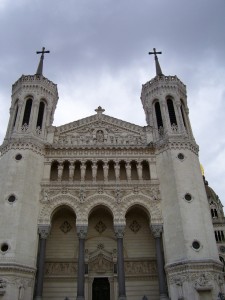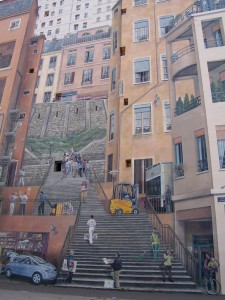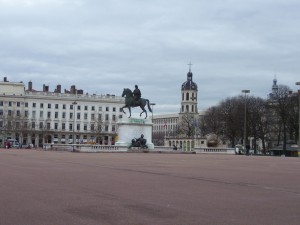THE RIVERS OF FRANCE- City of Lyon
THE RIVERS OF FRANCE
This is the sixth in a series of articles about a boat trip along the Rhone River
A DAY IN THE CITY OF LYON
By Charles N. Stevens
Photos by Dolores Seidman
After arriving in Lyon late in the morning, we begin a bus and walking tour of this great city, the second largest in France. Looking at its classic European appearance today, it is difficult to imagine that in the year 43 BC it was a vibrant Roman city and stronghold. Lyon lies at the confluence of the Rhone and Saone Rivers, most of it built on the peninsula between them. 400,000 people live in the city, and if you include the suburbs 1.3 million.
Our bus labors up the steep streets toward the highest hill in Lyon, passing several Roman funerary monuments on the way. We drive by a former castle now being used as a high school and then the spectacular ruins of a Roman theater built in 17 BC in the time of Emperor Augustus. Its circular array of seats is still in use for classical and jazz concerts. In Roman times marble covered the seats, but after it was abandoned the local people found their own uses for it. 10,000 people once gathered here for the theater productions. Nearby, young music students trudge up the sidewalk, some of them carrying their instruments on their back.
We finally reach the top of the hill and the magnificent Fourviere Basilica with its four towers, one at each corner. From afar the Basilica is sometimes irreverently referred to as an “upside down elephant”, the towers representing its upturned legs. This level area at the hill’s crest, the Esplanade Fourviere, was once the site of a Roman forum. No traces of it remain, so it is difficult to imagine that this was a once bustling area of commerce and trade. Before we enter the church we walk to the hill’s edge for a grand view of the city. Far below are the red tile roofs of the houses and buildings, the green trees edging the two rivers running through them. Far away, standing out in its loneliness, is Lyon’s only skyscraper, the Credit Lyonaise Building, affectionately called “the pencil” because of its round, thin shape and tapered top. The company sponsors the Tour de France bicycle races.
The early economy of Lyon, particularly in the 18th and 19th centuries, was based on silk and silk weaving. Today, many of the plain brick buildings where silk was once woven, all the windows facing south for adequate light, have been converted to luxury apartments. Weavers were never paid for their work until they had finished their product, so many of the workers were not paid for months, a cruel hardship. Finally laws against this practice were enacted in 1830. Some of the silk tapestries now hanging at Versailles and the coronation gown of Elizabeth II were woven here.
We pause in front of an amazing building. The surface of it is flat, but the scene painted on it appears to be three dimensional. It looks so real one would swear that there is depth to it. Depicted is a building with windows, stairs leading into an inner courtyard and various shops on the street level. All look as though they are real shops, stairs and windows, but is all a deception. A homeless man attempts to sit on one of the stairs to rest and, of course, slides to the ground. Even pigeons bouncy castle for sale try to land on one of the painted ledges, finding they are not there. The French call; these murals Trompe d’oeil, (trick of the eye). Over150 painted walls decorate the buildings of Lyon.
As the bus rolls through the area we see other murals on buildings, some several stories up. These are large portraits of famous people who have lived in Lyon—Paul Bocouse, the chef, Verazanno, the engineer who designed the bridge over the Hudson River in New York and the Lumiere Brothers who developed the concept of moving pictures on film.
We pass an equestrian statue of Louis XIV in Bellecour Square. A large banner protesting the new work laws is draped over part of him. There had been a large rally earlier, but it had now broken up, only a few students loitering around the statue. All around the perimeter of the park patrol cars and trucks of the local police keep a watchful eye for trouble.
Finished with the bus, we begin a walking tour. Near our starting point are automatic bicycle renting stands. Money is put into a machine that produces an electronic ticket and releases one of the bikes from the rack. When the rider is finished he can bring it back or drop it off at stands placed conveniently around the city.
We walk into a 9th century cathedral dating from the time of Charlemagne. The most spectacular object in the church is a huge astronomical clock, hundreds of years old. It still functions and springs into action at noon. As we stroll around inside the church we notice that statues are missing from their niches and the stone angels around the arch are all beheaded, the result of religious intolerance, Protestant against Catholic, in the 16th century.
We duck into a traboule, a “secret walkway.” behind a plain door in about the middle of the block. This passageway leads into a confusing complex of apartments. Another leads to more apartments and a photography shop. A spiral staircase in a large tower leads to other lodgings above. These maze-like passages and hideaways were valuable to the French Resistance during World War II.
We stand on the deck of our ship at night admiring the nearby university buildings bathed in the yellowish light of flood lamps. Green neon lights trace the outline of the bridge that crosses the Rhone just in front of us. Bright lights shine on the bridge itself, illuminating some of the decorative medallions on its side. The nearest one bears a scrolled “RF” meaning “Republique Francais”.
The day had been full, and we are tired, but this last look at Lyon by night is a perfect ending.

The magnificent Fourviere Basilica stands on Lyon's highest point.

Believe it or not all that you see in this photo is painted on a flat wall.

Louis XIV rides in Bellecour Square, a common gathering place for protesters.



